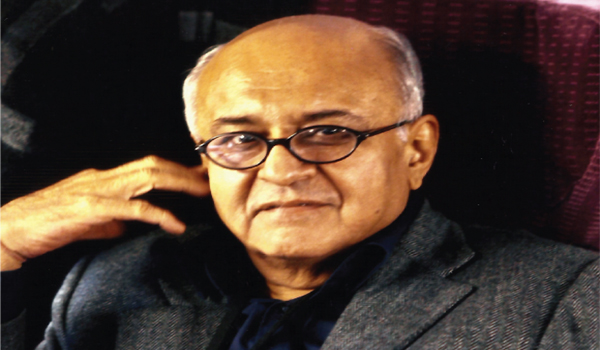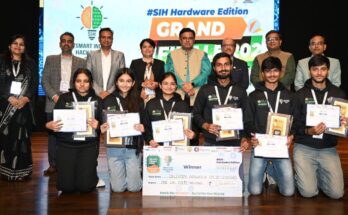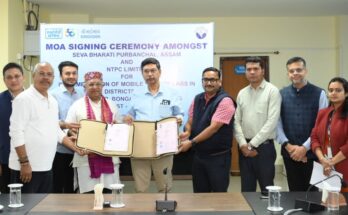New Delhi, Dec 13 What is striking about Amit Khanna is not just the fact that he has been part of the entire media spectrum — television, films, radio, print, studio head, besides being part of policy making, but that he refuses to wear any stars on the shoulders.
“For me, it has always been important to explore newer challenges,” smiles the lyricist, producer, filmmaker, poet and former Chairman of Reliance Entertainment.
As his second book “Words Sounds Images: A History of Media and Entertainment in India”, an encyclopedic study of the history of Indian media and entertainment, published by HarperCollins gets released today, he tells IANS: “We’re aware that India has an ancient tradition of music and dance, theatre; later print, radio and television, and now digital — so the book covers everything.”
Khanna, who has been consistently writing on the Indian media and entertainment scenario for decades now, says the idea of writing this book emerged after he started interacting with students and young professionals. “I realised there was no one book which could be accessed to give an overview of Indian media and entertainment.”
A keen observer of culture, society and contemporary trends, the media veteran who also mentors several youngsters now plans to travel and spend time teaching. “It is always interesting to interact with young professionals.”
For someone who has donned multiple hats in the media segment and has done several things simultaneously, it is giving inputs to policy that is on top of his priority list now. “Somebody has to engage with and deal with what is going to happen in various media in the years to come, and how others respond to it — whether it is the government or other stake holders. For me, exploring new frontiers is always interesting.
“Today, we exist in a networked society. It’s the first time in human history that four to five billion people are connected. This is an interesting age to be in and at this stage of my career, I want to observe, analyze, various media in terms of social and cultural change, and how do we use future as a friend. Yes, it is therefore a very fulfilling kind of engagement,” he adds.
Khanna, who has always stressed that government should focus just on making broader policies but stay completely away from businesses, insists that it holds true not just for media and entertainment but other industries too.
“All successive governments have said that government has no business to be in business, but it is very difficult for them to give up control. Of course, now things are less restrictive than they were 30 years ago. Unfortunately, in a democracy, where electoral politics is a major policy motivator, most politicians tend to be populist rather than commonsensical, something the country needs desperately.”
No conversation with a media expert can be complete without mentioning OTT. He says, “Let’s not forget it’s merely a platform. There are a few points in this value chain. It’s the creator and access. How does the consumer access that content? So, platform, after a point becomes irrelevant. You have to be platform agnostic. How does it matter where I am accessing the content I want to see or listen to, from? I really shouldn’t care if it coming to me through the sky, broadcast TV, direct to home, broadband or mobile Internet, right?
“We are in the phase where we are still concerned with platforms. I thought, over a passage of time, we would get under regulated, but sadly, we are getting over regulated. It’s a global phenomenon though in India, it’s more accentuated.”
Talk to him about the fact how many news outlets are recording an all-time low profit and shutting shop, and he asserts, “It’s do with the number of them. This country has more than 800 news channels. Things are way too fragmented. Let us also not forget that in India, the per capita spend on entertainment is the lowest among all large emerging economies.
“If you’re spending an hour on the phone now, that much time has been reduced from the activities you were participating in before, right? These channels will have to shut down. Some local channels and specialized digital platforms, which are a democratic medium and cost much less in terms of investment, will see a rise. Of course, one also needs to see what is their business model for sustenance and growth?”
Khanna, who set up PLUS Channel in 1989, India’s first integrated media and entertainment company that produced three hours of programming everyday for Doordarshan feels it is high time that the state broadcaster gets it act together.
“I was the Executive Producer of ‘Buniyad’ and producer for ‘Swaabhimaan’. Now, when you look at Doordarshan, it’s apparent that the standards and practices of state broadcasting in India are way behind. It is important for the government to realise the peculiar role of a public broadcaster in a pluralistic country like India, which boasts of several languages and cultures.
“Yes, we do need a public broadcaster, but it does not have to do what every private broadcaster is doing. I mean why should every cricket match should be shown on Doordarshan? That’s a stupid regulation. They just need to stick to good quality commissioned programming.
“Professionals need to be brought in immediately and given a free hand. Failing this, it will go the same road as BSNL, MTNL and Air India.”
Insisting that it paramount to invest on manpower training and development in media and other sectors, the media veteran, who has been on the governing council of FTII (Film and Television Institute of India), Pune and SRFTI (Satyajit Ray Film and Television Institute), Kolkata besides the board of MCRC (Mass Communication Research Centre), Jamia Millia Islamia, points, “When I was on their boards, I would constantly tell them to update their teaching methods which were decades old. We have to have excellent facility. Inviting guest faculty is a good short-term solution, but the need of the hour is to get trainers from abroad to teach the instructors and teachers on the latest breakthroughs in their subjects.”




